How it Works: Preen Garden Weed Preventers
Here's how our Garden Weed Preventers prevent weeds before they even sprout rather than killing them after they’ve already had the chance to grow.
Spring bulbs are among the earliest flowers to bloom in the New Year. As winter loses its grip you can have a floral show waiting to pop, only if you planted the bulbs the previous fall.
Throughout most of North America, particularly in colder regions (Zones 7 and below), September through November is the prime time to plant bulbs. Don’t try to get them in before the soil temperature drops to the 50s at night. This gives the planted bulbs time to put down roots, before the ground freezes. As long as the soil is not frozen, it is not too late to plant. Bulbs planted too late however may not give off their best the following spring. In warmer regions, lack of winter cold means buying and planting tulips, hyacinths, and other bulbous favorites that have been pre-chilled. Either way, you will have to wait until late winter to early spring before you see young shoots emerging. But it’s well worth the wait for these showy beauties.
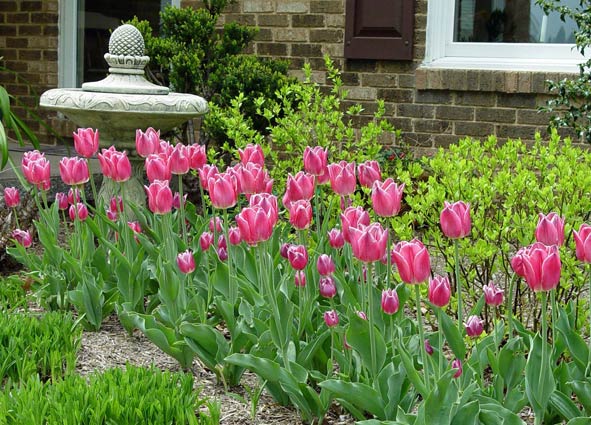
© George Weigel
Some gardeners find it difficult to incorporate bulbs into their landscape because once their early-season flowers fade, spring bulbs die back and become dormant through summer, fall, and winter until a new cycle begins again. That raises the question, “What do I do about that bare space in summer?
You’ll get the most bang for your bulb buck by planting spring bulbs where you – and others – will see them the most, generally along the front of the house, in a front-yard garden, or along an entryway or path. Best planted in clusters or masses, as opposed to single, straight lines, plant at least 10 or 12 bulbs in each grouping. These could be by the front door, around the mailbox, around a driveway light post, or flanking a gate or arbor. Plant the space between the bulbs with summer annuals, including petunias, marigolds, vinca (Catharanthus rosea), zinnias, or celosia. Insert young annuals carefully between the bulbs, trying not to damage the bulbs. If you accidentally dig bulbs up while planting, just put them back in the ground, or you might decide to move the bulbs elsewhere. Bulb foliage should only be cut to the ground after it has matured and yellowed. The annuals will fill the space with color until frost, and camouflage the dying bulb leaves.
Bulbs and perennials share space well. When snowdrops, daffodils, crocuses, hyacinths, tulips, and most spring bulbs are put on display in the garden, most perennial flowers are just starting to leaf out. Gradually as the perennial plants begin to take over, the bulbs have finished and are starting to die back. Sedum, hosta, daylilies, goldenrod, lilies, phlox, black-eyed Susans, and coneflowers are some of the best companions for bulbs.
An alternate solution is to coordinate bulbs with some of the earliest blooming perennials. These might include a combination of April-blooming pink tulips (‘Christmas Pearl’ perhaps) interplanted with perennial foamflowers (Tiarella), that have pinkish-white flowers, also in April. Do some research and find some similar-timed bulbs to combine with existing early perennials. You will have fun experimenting and transplanting to come up with new coordinated pairings.
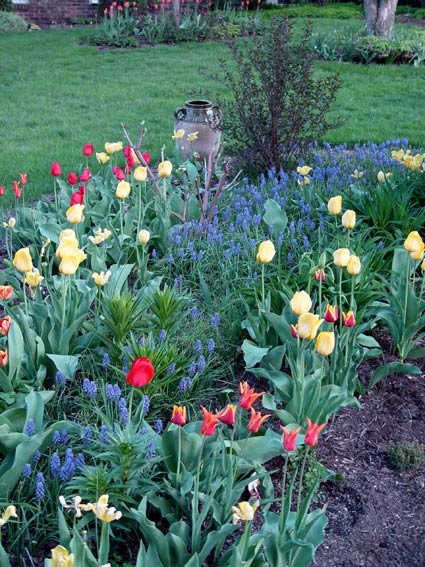
© George Weigel
Bulb shoots are adept at finding their way up through low groundcover plantings, such as commonly used vinca (Vinca minor), sweet woodruff (Galium odoratum), deadnettle (Lamium), leadwort (Ceratostigma), and creeping sedum. The ubiquitous pachysandra is too greedy to support healthy bulb growth. Even if you already have a thick groundcover in place, bulbs can be inserted right into the ground (use a bulb auger or slender trowel) through the foliage. Bigger bulbs work best for this purpose– ones that are tall and strong enough to grow through and over the groundcover carpet. When in bloom, the color from the bulbs will add a new dimension to what is otherwise a static and/or plain green mass. Daffodils, hyacinths, tulips, Spanish bluebells, and alliums are good choices for this. Allow the bulb foliage to brown in late spring so you can pick or rake it off instead of clipping it off with pruners. Your familiar solid groundcover will be fine for the rest of the season.
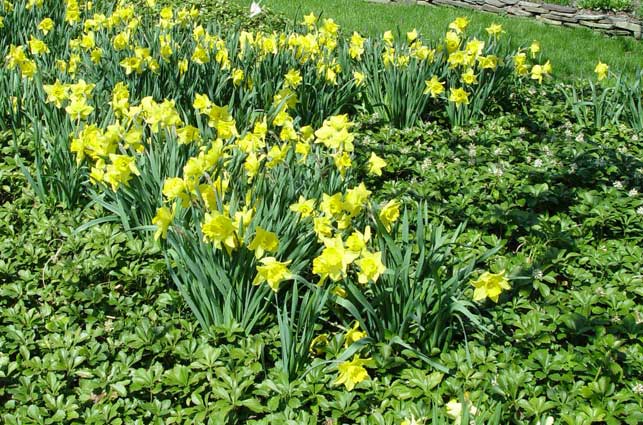
© George Weigel
In moderate climates, bulbs can be planted in pots or window boxes in fall and left outside to bloom in spring. Just be sure to use large weather-resistant containers, such as foam or heavy concrete ones, so you don’t end up with cracked terra-cotta pots at the end of winter.
In cold regions, an option is to plant the pots in the fall and store them in an unheated garage or shed over winter. Water thoroughly after planting and check on them regularly every 3-4 weeks; if necessary give each pot a small amount of water … just enough to keep the soil from becoming bone-dry. Bulbs for window boxes can be planted in the plastic liners that can be removed. Bury the planted liners over winter (a cold frame filled with compost or straw works well); re-insert the liners in the boxes when the bulb shoots begin poking up in spring. Most spring bulbs are winter-hardy to Zone 4, and many are hardy to Zone 3. Soggy soil and rodents are bigger threats to bulbs than winter cold. When the bulbs die, either plant the bulbs in the ground or store them inside in a cool, dry place for replanting in the fall. Then replant the containers with summer annuals.
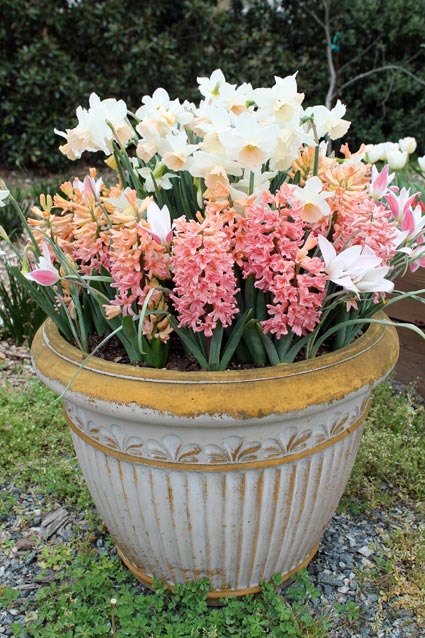
© George Weigel
Many trees have rings of bare mulch around them, either where the tree roots killed the grass, or gardeners removed that competition intentionally. (Tree roots don’t appreciate grass competition any more than grass tolerates the shade and competition of tree roots.) Most bulbs do reasonably well in dry shade under trees and can provide needed color in spring. Bulbs usually get enough sun to “recharge” before the trees leaf out, at least for a few years. As the trees create shade and hit peak moisture-using time, the bulbs go dormant; they actually prefer the dryness in summer. Dwarf daffodils, Siberian squill, grape hyacinths, crocuses, and glory-of-the-snow are some of the best in this setting. If they begin to thin out or stop blooming in a few years due to the tree competition, plant new ones. Set a few pots of shade annuals under the trees, or plant annuals that tolerate dry shade and root competition, such as begonias, coleus, or nasturtium.
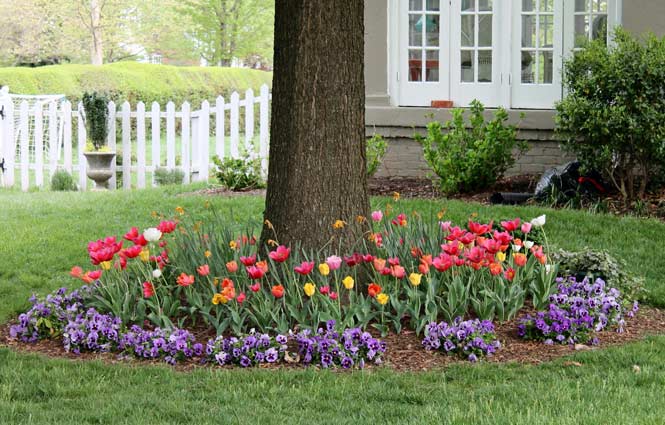
© George Weigel